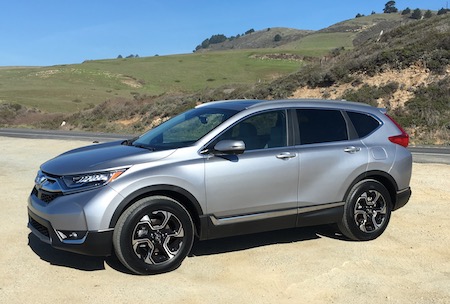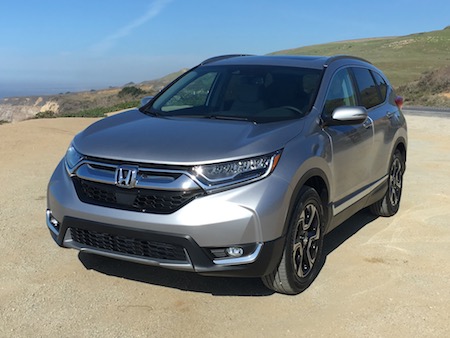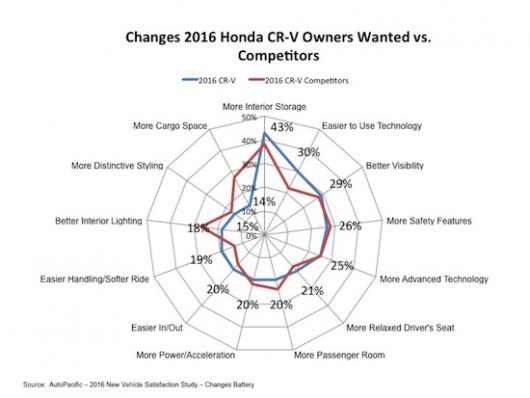All-New 2017 Honda CR-V – Improved Across the Board
- December 2, 2016
- Ford, Honda, Nissan, Toyota
- Posted by George Peterson
- Comments Off on All-New 2017 Honda CR-V – Improved Across the Board
The 2017 Honda CR-V goes on sale in December 2016. It’s predecessor, the fourth-generation 2016 Honda CR-V, is on track to sell about 380,000 crossover SUVs in 2016. It is the highest volume crossover SUV and one of the top selling vehicles in the market. In AutoPacific’s Vehicle Satisfaction Award Research the CR-V achieved a score of 690. This is a fourth place showing in the Mid-Size Crossover SUV segment. Nissan Rogue (712), Toyota RAV4 and Subaru Forester place ahead of the 2016 CR-V. In AutoPacific’s 2016 Ideal Vehicle Award Research the CR-V was tied with Rogue in third place (1134 points). The class leading Subaru Forester (1175) and Mazda CX-5 scored higher.

Each year, AutoPacific surveys new car and light truck buyers to determine what changes they want in their vehicle. It is particularly interesting to compare the changes that owners want to their vehicle when it is just about to be replaced by the next generation. Also, AutoPacific’s research can be measuring stick on how well a manufacturer’s product planners, engineers and designers understand their customers. Using AutoPacific’s research to determine what changes people wanted in their CR-V, let’s see how well Honda did with their update.

Source: AutoPacific – Radar Chart Showing Changes 2016 Honda CR-V Owners want Compared with Competition
Technology – Still a Challenge as With Most New Generation Vehicles: As with many vehicles these days, technology is a love it/hate it affair. About 25% of 2016 Honda CR-V owners want more advanced technology than now. About 30% want the technology they have to be easier to use. The 2016 CR-V has the HondaSensing suite of driver assistance technologies available. The 2017 version expands on that adding a blind spot information system to the affordable EX model. Technology is still an area that requires a great deal of work, and the 2017 Honda CR-V improves on its predecessor. About 25% of CR-V’s competitors want more advanced technology as well. Among competitors, about 34% of 2016 Ford Escape owners want easier to use technology.
Driver’s Seat Visibility – Excellent View: Visibility is a key component in the acceptance of new crossover SUVs. About 29% of 2016 Honda CR-V owners want better driver’s seat visibility compared with 27% for competition. The previous CR-V was very competitive, but AutoPacific concludes the fourth generation CR-V is better. The driver’s seating position is excellent. The hood has been redesigned with more character that gives the driver more reference points in front. Honda has always been generous with glass and it appears the windows are larger. The 2017 CR-V should see better results next year.
Power and Fuel Economy – Going Turbo: About 20% of 2016 Honda CR-V owners want more power and acceleration and about 10% would sacrifice power and acceleration for better fuel economy. About 29% of 2016 Nissan Rogue owners want more power and acceleration. The 2017 Honda CR-V adds a 190-horsepower turbocharged 1.5L 4-cylinder in all but the base LX model. The turbo 4 gets both better fuel economy and acceleration and feels sprightlier than its predecessor. 2017 results should be even better than 2016.
Ride and Handling – Improved Dynamics: About 20% of 2016 Honda CR-V owners want easier handing and a softer ride. This compares to just 14% of the owners of its primary competitors wanting easier handling and softer ride. Honda has improved the ride and handling giving the 2017 CR-V a solid ride with crisp sporty handling. It is not a pillow-soft ride by any means, but gives the confidence that the vehicle will do what the driver demands.
Passenger Roominess – More Rear Seat Room: About 20% of 2016 Honda CR-V owners want more passenger room. This compares with about 24% of competition (about 32% of Ford Escape owners want more passenger room). The 2017 Honda CR-V has 2.1-inches more rear seat legroom while increasing the overall length of the vehicle by 1.2 inches. The rear seat seems much more spacious and the 2017 Honda CR-V should fare even better in AutoPacific’s 2017 research.
Exterior Styling – More Distinctive – Upscale: Looking at the all new CR-V, the at-a-glance impression is “more of the same”. CR-V, however, adopts Honda’s more aggressive and distinctive front end design with a heavy dollop of chrome. The taillights are a blatant evolution of the 2016 CR-V. About 16% of 2016 CR-V owners want more distinctive styling. 23% of owners of the 2016 Ford Escape, for instance, want more distinctive styling. It is probably safe to say that the 2017 changes to the CR-V will move the needle towards the more distinctive area.
Cargo Area – Even Better: 2016 Honda CR-V owners are less likely to want more cargo space than the competition – 14% compared to 28%. The 2017 Honda CR-V adds almost 10-inches to the length of its cargo space. This makes the all-new CR-V even better than before and substantially better than each of its main competitors.
Overall: The 2017 Honda CR-V has incrementally improved in almost every area. The styling is more distinctive. The powertrain more responsive. The interior is larger within a vehicle that is no bigger than before. Combined with Honda’s outstanding ergonomics, the CR-V, as a product, should be able to sell at about capacity especially at the aggressive pricing Honda has adopted.
Competition does not stand still. The Ford Escape has a substantial upgrade for 2017. The Nissan Rogue is all new for 2017. The 2017 research will show which vehicle’s product development team understood its customers the best and executed the product for them.

